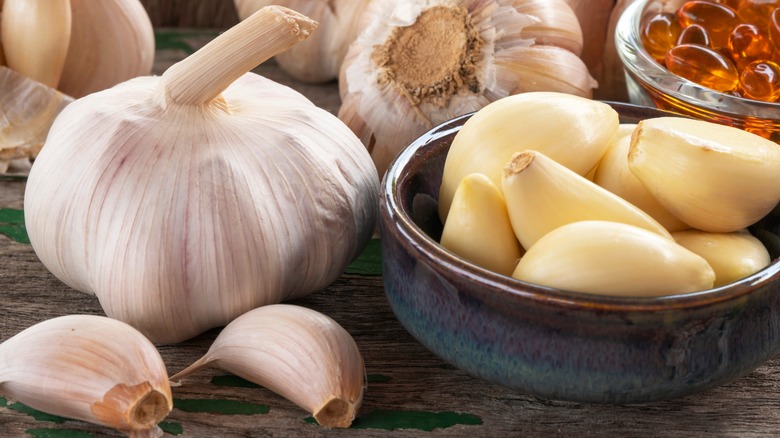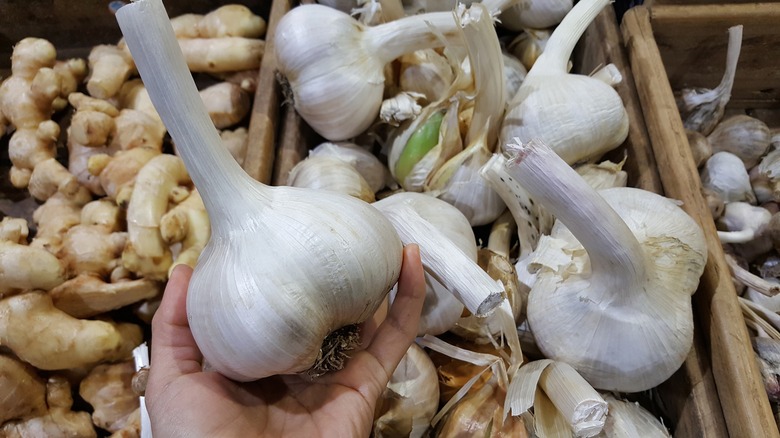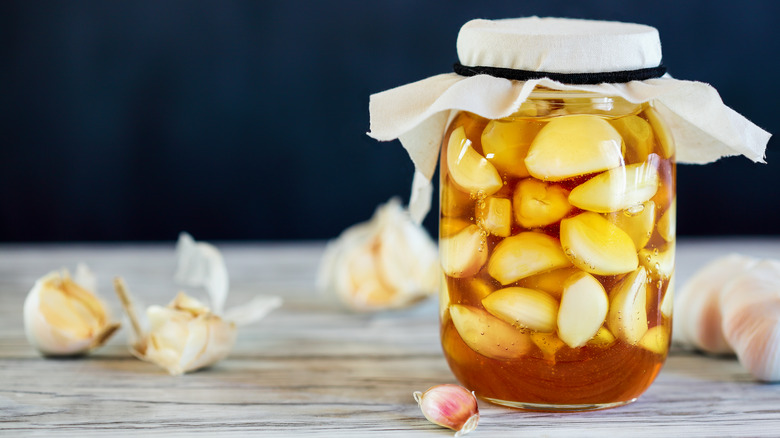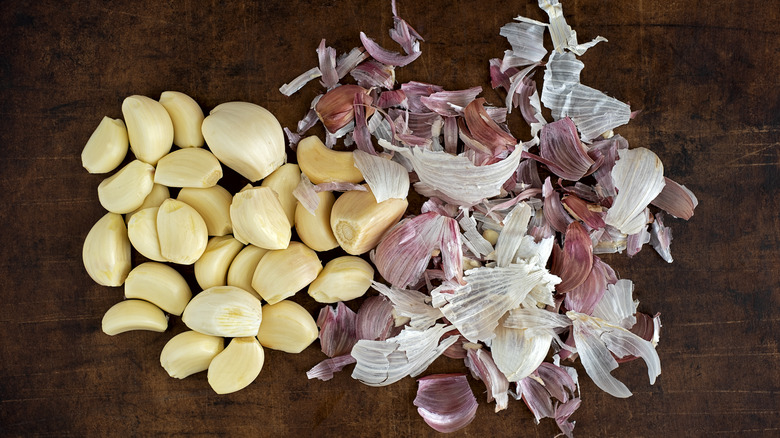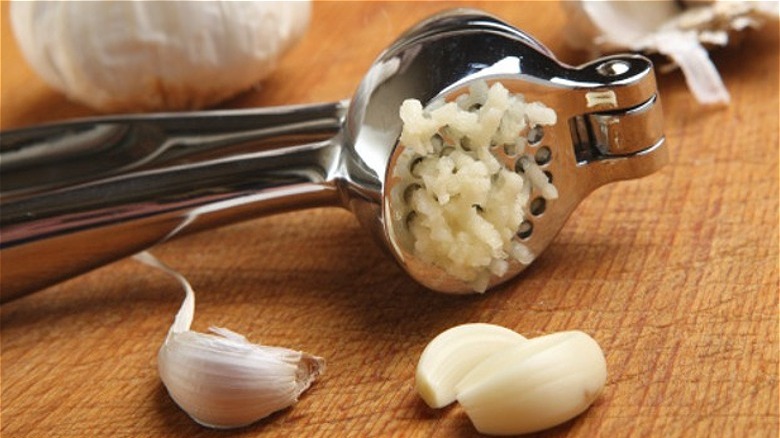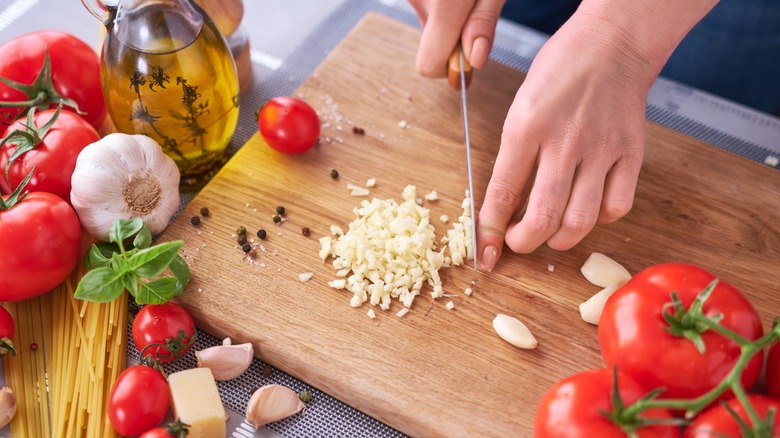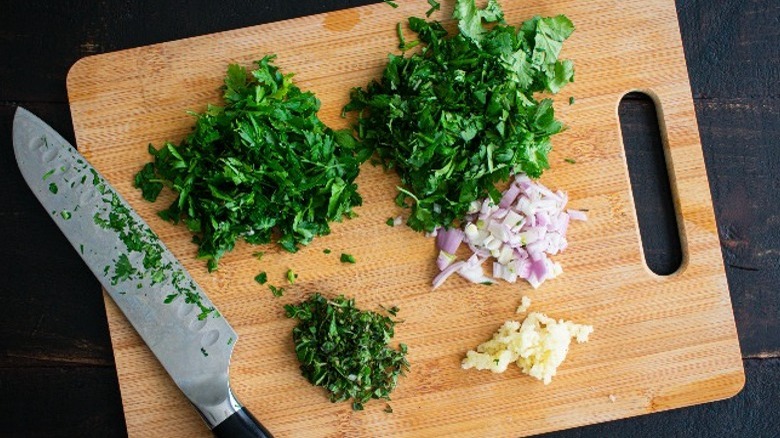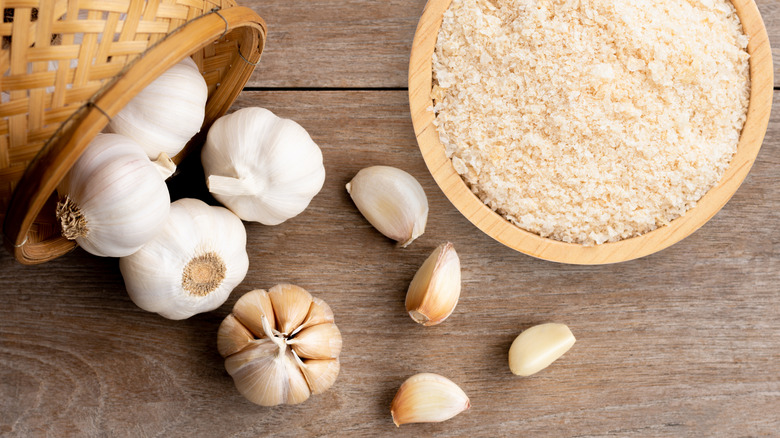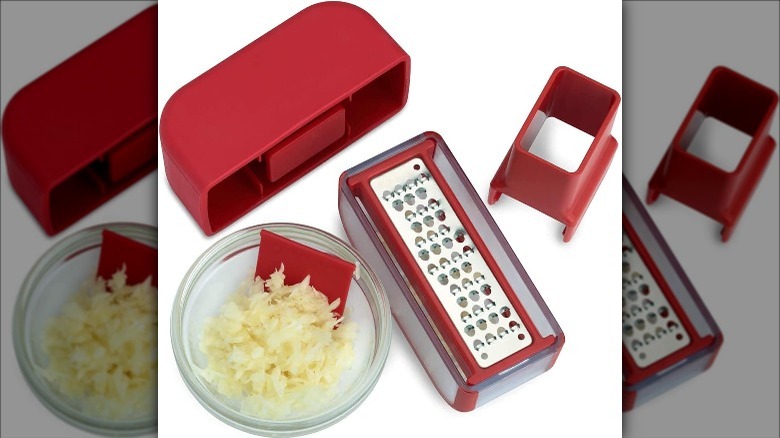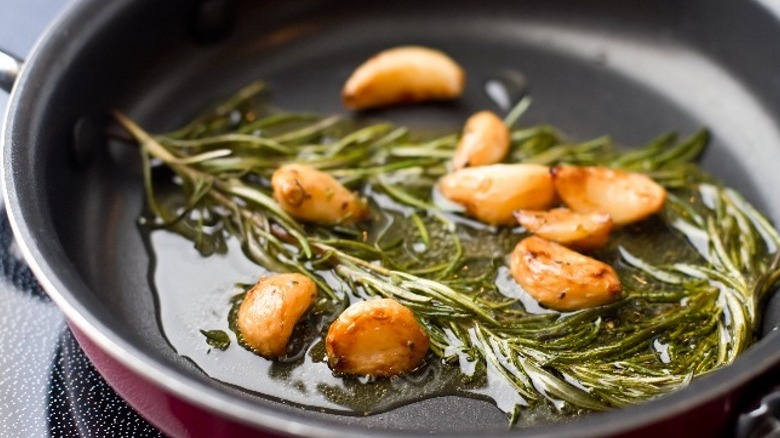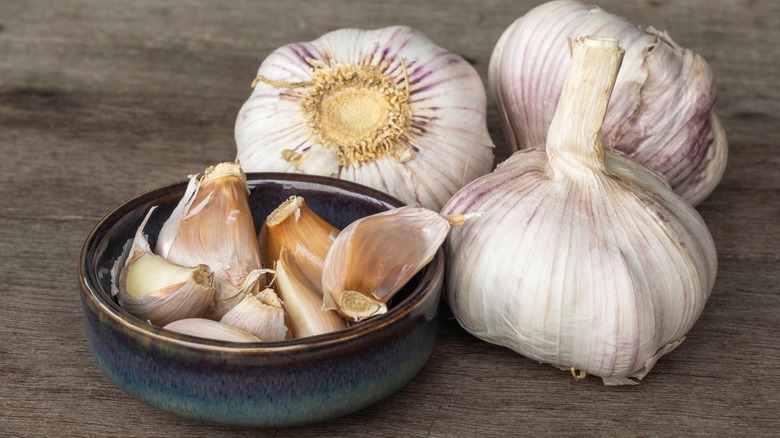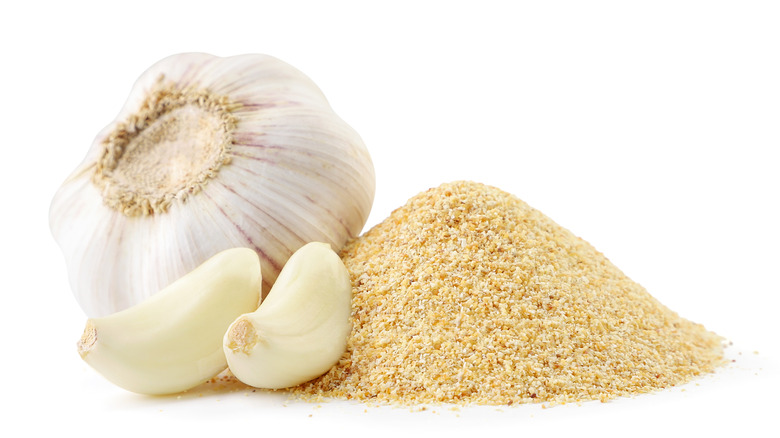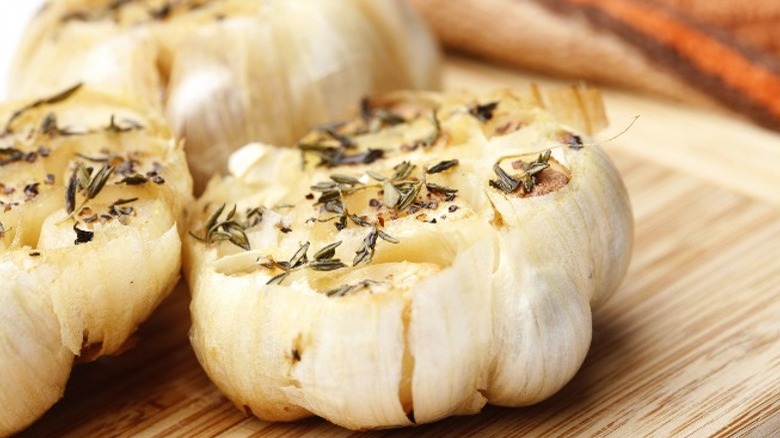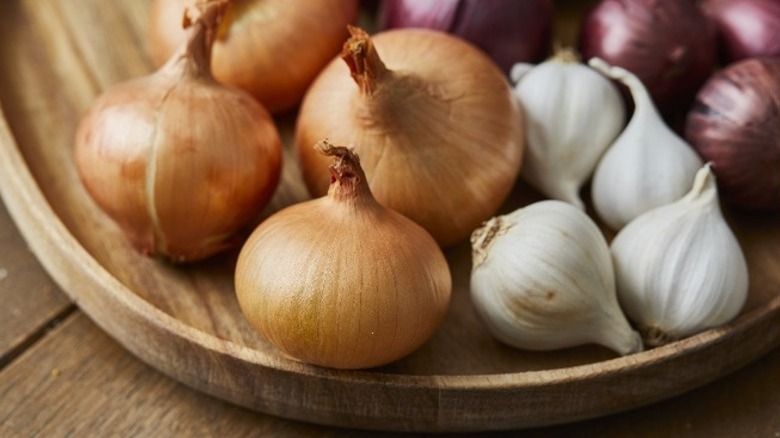14 Mistakes People Make When Using Garlic
If you look in most kitchens, one of the staples that you're likely to find is garlic. Garlic is used when making many recipes, from garlic knots to spaghetti sauce to barbecue sauce, and so many more. Depending on how much garlic you add to a recipe, it can really pack a punch. But when used in smaller quantities, it can help add a nice flavor. There are many ways to prepare garlic, so there are many ways this preparation can go wrong.
That's right, using garlic isn't as straightforward as you may think. Depending on the specific mistake you make, you could end up changing the way a recipe is supposed to taste or depriving yourself of some of the health benefits associated with cooking with garlic. You may even end up making more work for yourself in the kitchen, which is never a good thing. If you're ready to stop making mistakes when cooking with garlic or want to learn some tips to help improve your recipes, keep reading.
1. Not knowing how to choose the best garlic
If you're at the grocery store or farmer's market shopping for garlic, it's important to know how to identify fresh garlic. One of the first things you'll want to do is grab one of the bulbs and squeeze it gently. If you feel too much give, or it feels as if some of the cloves are hollowed out or overly dry, put the bulb down. These are both signs that the garlic is not fresh. Similarly, any cloves that have started sprouting should also be avoided — they are likely too old.
Instead, a fresh garlic bulb should feel rather firm. When you squeeze it, it should not have much give. The ideal choice is to look for locally-grown garlic. It won't have traveled long distances to make it to your grocery store, which means it is much more likely to be fresh.
2. Buying jarred garlic
You've undoubtedly walked by the jars of garlic at your grocery store. Perhaps, you even bought them a few times so that you could still cook with full cloves of garlic without having to deal with the hassle of peeling them. However, this is a mistake that you won't want to make again. There are several reasons why it is best to stay away from jarred garlic.
First, the flavor of jarred garlic just doesn't compare to that of fresh garlic. This is because garlic gets more pungent as soon as it is cut. With jars of previously minced garlic, the flavor of your will be more muted when combined with your dish.
Another reason to stay away from jarred garlic is that it's pasteurized. When it is pasteurized, the garlic also loses more of its nutritional value. It also tends to be more expensive. Plus, because the taste isn't as strong, you're also likely to end up using more, which can make it even more costly to buy your garlic in the jarred format.
3. Not knowing the best way to peel garlic
If you're going to cook with garlic, you need to know how to peel it. Fortunately, it isn't too hard to peel garlic, as long as you know what you're doing. There is no need to use your fingers or a knife and you shouldn't end up smelling like garlic. One of the best — and easiest — ways to peel garlic barely requires you to touch the cloves at all.
Start by pressing the palm of your hand down on the center of the garlic bulb. This will cause the individual cloves to easily separate. Then, place the cloves in a big bowl or a large mason jar — there should be a lot of extra room. Cover the bowl with a plate or place the lid on the mason jar. Use your hands to shake it for about 30 seconds. Make sure you're shaking pretty vigorously, or this approach will not work. When you remove the plate or lid, all of the garlic cloves should be peeled, and you'll just need to remove the skin. If they're not all peeled, return the lid or plate and give it all a few more shakes.
4. Pressing garlic instead of mincing it
If you have a garlic press, you might want to stop relying on it so heavily when adding garlic to a recipe. When you press garlic, you're left with numerous tiny chunks that are distributed throughout the dish you're cooking. One would think that this would result in a more mild flavor since the garlic isn't concentrated in any one area. However, this is not actually what happens. When garlic gets pressed into tiny pieces, it actually makes the flavor more intense, which can even end up overpowering the other ingredients in your recipe.
Another reason to avoid using a garlic press is that it can alter the texture of the dish. Additionally, it could make it more likely to burn when you're sautéing it than if it had been minced or chopped.
5. Not knowing how to mince garlic
Now that it has been established that pressing garlic is a mistake, you have probably realized that mincing it is the best tactic. Luckily, it isn't too difficult.
After peeling the garlic cloves, use a knife to trim off the dark edge of the clove and then thinly slice them. After slicing, you're ready to start mincing. Hold the knife at a slight angle, keeping one hand on the handle and the other on the top edge of the blade. Rock the handle back and forth to move the blade over the garlic. Continue repeating this motion until the garlic is minced into fine pieces.
6. Not letting garlic rest after mincing
After you've finished mincing garlic cloves for your recipe, the best choice is to let them rest for a few minutes before actually adding them to the pot or pan. Garlic cloves contain allicin, a compound that has been shown to help boost the immune system. When you let the garlic rest, it gives allicin and other sulfide compounds a chance to develop more fully, which can maximize their health benefits.
The reason that allicin and other sulfide compounds develop more fully when chopped garlic sits is due to the chemical reaction that occurs between the oxygen in the air and the enzymes that are released. It doesn't take long for this reaction to occur. A 10-minute rest should be sufficient.
7. Peeling garlic before pressing it
Many people think that they have to peel garlic cloves before putting them into a press. However, adding the extra step of peeling the clove is actually unnecessary.
When you put an unpeeled clove of garlic in your garlic press, it will actually press the garlic through the clove and onto your cutting board or into your pan. The peel of the garlic is left inside the press, and all you need to do is remove it. If you've been taking the time to peel each clove, now you can start thinking about what you'll do with all the extra time on your hands in the kitchen.
8. Substituting garlic powder for fresh garlic
With all of this talk about selecting, peeling, pressing, and mincing garlic, is any of it really necessary when you can just go to the grocery store and pick up a bottle of garlic powder that will last for a long time? While there are some times when this can certainly come in handy — such as when making a dry rub or a dip — it should not be seen as a suitable substitute for fresh garlic.
To make garlic powder, fresh garlic is dried and ground down. This process alters the flavor, making it much more mild and not as flavorful. If a recipe calls for fresh garlic cloves, or you really want to be able to taste the garlic in each bite, don't even think about substituting garlic powder. It just won't be the same, and you'll end up disappointed with the finished dish.
9. Microplaning garlic cloves
While it may seem easier or quicker to use a microplane grater to finely chop each garlic clove, doing so isn't a good idea. Just as using a press can result in a very overpowering garlic flavor in your dish, the same is true when you use a microplane.
The reason for this is that using this tool causes more molecules in the garlic to rupture. The more molecules that are ruptured, the stronger the garlic flavor is going to end up being. If you want to ensure that your recipes have a nice garlic flavor, without it being completely overpowering, it is best to stick with mincing.
10. Burning garlic when sautéing it
Burning garlic is another mistake that you will want to avoid. Burnt garlic isn't going to smell particularly pleasant and certainly won't contribute the flavors you were hoping for in your finished recipe. he small bits produced by mincing and pressing are even more likely to burn, so you'll definitely want to be careful when cooking them and aim to add them after your other ingredients have had time to cook.
Adding garlic to the pan too early isn't the only thing that can make it more likely to burn. Getting the pan too hot may also contribute to the problem. To further minimize the chances of burning your garlic, don't cook it over high heat; medium or even low should be sufficient. If needed, increase the burner temperature when you're almost finished cooking. You can also help reduce the risk of ending up with burned garlic by cooking it in fat, such as oil or butter.
11. Confusing a clove of garlic with a head of garlic
Some people use the terms "garlic clove" and "garlic head" interchangeably. However, they are not the same thing, and confusing them when preparing a recipe could have disastrous results. A head of garlic refers to the entire bulb or group of segments stuck together; this is what you purchase at a grocery store.
A clove of garlic, on the other hand, refers to just one of the segments from the head. These segments separate from one another if you press down on the top of the head or pull them off individually. Each one is made up of several cloves. So, as you can imagine, it would be a pretty big mistake to use an entire head of garlic if the recipe calls for a clove. Your recipe is likely to turn out very overpowering and unenjoyable.
12. Not knowing how to substitute fresh garlic for garlic powder
Sometimes a recipe may call for garlic powder. If you have fresh garlic on hand, you may want to substitute it in the recipe to help boost its flavor. Before you can do this, however, you need to understand how much fresh garlic you will need to use in place of the garlic powder.
A general conversion to keep in mind is that each garlic clove, on average, equals 1/8 teaspoon of garlic powder. So, if you're looking to replace garlic powder with fresh garlic, aim to add approximately eight cloves for each teaspoon that the recipe calls for.
13. Ignoring the benefits of roasted garlic
If you've never tried roasting garlic, then that is a mistake that you'll want to remedy as soon as possible. Roasting garlic is easy and yields a truly tasty treat. All you need to do is peel off the thinner layers covering the head of garlic (do not peel each individual clove). Then, cut off about 1/4-inch from the top of the cloves to expose their insides. Put each cut head into a muffin pan — with the cut side up — drizzle a little olive oil over the heads, and cover them with aluminum foil. Bake in a 400-degree Fahrenheit oven for about 35 minutes.
After the garlic has finished roasting, you can actually eat it straight away. The chemical structure of the garlic is changed during the roasting process, leaving it milder and easier to digest. While it is good on its own, but roasted garlic can also be used for a variety of other recipes, including adding it to pasta dishes, mixing it into your mashed potatoes, making homemade hummus, and preparing garlic bread.
Beyond its pleasant taste, eating roasted garlic can also be good for your heart and may help to control blood pressure. When combined with a balanced diet, it may also help to bring down cholesterol levels. Eating roasted garlic may also help protect you against certain types of cancer, improve digestive symptoms, and boost your immune system.
14. Not properly storing your garlic
If you do not store your garlic properly, then it isn't going to remain fresh as long. One of the most important things to remember is that it should be kept dry. If the garlic gets wet, it can rot and become moldy. For this reason, you should never store it in the refrigerator with your other vegetables.
Instead, the best place to store garlic is in a dark and dry cabinet. Before putting it in the cabinet, place the head of garlic in a small paper bag. Alternatively, you can also leave it on the counter with onions and other produce that doesn't need to be refrigerated — just be sure to keep it away from anything wet. If you keep your garlic stored properly, you may find that it lasts for months. There are many advantages to storing your garlic correctly.
